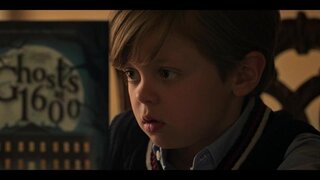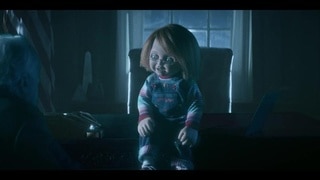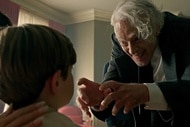Create a free profile to get unlimited access to exclusive videos, sweepstakes, and more!
Annabelle, Chucky, and Talky Tina: Why Are Dolls, Like, So Creepy?
Digging into the terror of why dolls are just so darn scary.
Ghosts, demons, slasher killers, and creepy dolls populate the Mount Rushmore of fright. The first three on that list have an obvious fear factor. Should you encounter any one of them, it’s clear why a fear response would be appropriate. But what’s the deal with dolls?
Dolls are objects that exist firmly inside the realm of reality. They are some of the first objects we encounter in childhood. Not only that, but they are objects of play, specifically designed to elicit joy. It’s unusual, then, that they would become the subject of enough horror media to warrant their own subgenre. The Annabelle films, Puppet Master, The Twilight Zone's Talky Tina, Tales From the Hood’s "KKK Comeuppance," and of course the Child’s Play franchise are just a smattering of the deadly doll-based movies you could queue up right now if you were of a mind. With the back half of Season 3 of SYFY and USA Network's Chucky in the works right now, it's the perfect time to make sense of the phenomenon.
There’s not been much significant research conducted on the specific creep factor of dolls, but the phenomenon falls into the larger relationship we have with inanimate objects, specifically those objects that look sort of like us. The notion of the Uncanny Valley was first suggest in 1970 by roboticist Masahiro Mori. He suggested that acceptance of robots would increase as they became more lifelike, but only up to a point. Then it becomes abhorrent. This phenomenon applies not just to robots, but to anything that attempts to appear humanoid, including dolls.
How do toys become scary?
It can be best illustrated by putting dolls on a spectrum from ancient stone or wood carvings to modern toys. There’s nothing all that frightening about a rudimentary stone carving. Looking upon it triggers some recognition of its base features and perhaps allows the player to use it as an avatar for the imagination, but little else. Gazing into the glassy eyes of a more modern doll, however, elicits a different set of reactions altogether. And you can blame evolution.
Our minds have developed in such a way that they recognize and react to certain stimuli in order to better ensure our survival. To that end, we’ve learned to distinguish between wholly inanimate objects and those that might have a mind. More particularly, those that might have a mind to do us harm. It’s the reason our brains are so innately primed to recognize faces. In fact, we’re so primed to recognize faces that we often see them where they don’t exist.
Studies have shown that this facial recognition behavior is present almost from the moment of birth. In one study involving infants with a median age of just nine minutes, they found that children pay attention to faces more readily than randomized stimuli, suggesting it is an innate property of the way the brain is organized, as opposed to a learned behavior.
The mind doesn’t stop, though, at just recognizing face-like structures. Once targeted, it moves into secondary calculations. The question then becomes whether the object in question is lifelike enough to pass muster.
Ayse Saygin, a cognitive scientist at the University of California, San Diego, speaking to Scientific American, said, “I think the key is that when you make appearances humanlike, you raise expectations for the brain. When those expectations are not met, then you have the problem in the brain.”
And therein lies the key. The brain first looks for identifiers that indicate a human, or human-like, face. These faces don’t even need to be wholly human. Research indicates the closer a species is to human, the more we care about them, namely because we project human characteristics onto them. Those species that we emotionally determine to be more like us receive higher funding for conservation and are more likely to be attributed to moral rights.
We imbue those non-human animals with a sense of mind. We recognize a thinking and feeling individual there. We see them as beings. They pass the test. This is where we run up against a wall with dolls and similar inanimate objects. They check the first box. We recognize them as having features pertaining to a potential thinking and acting thing, but they don’t give us any of the additional cues we associate with a mind. And that’s where our brains go haywire.
How our brains make us scared of dolls
Saygin suggested that when we place an object into the first box, recognizing it as a potential being, we start to look for other cues, and when we don’t find them, when those objects fail to satisfy the requirements for life, we fall into a state of alarm.
It’s the brain-state equivalent of someone keying in most of a password, but failing on multiple attempts. A klaxon fires, warning the brain that someone, or something, is attempting to get in. These same emotions trigger when we encounter someone who subverts recognized social cues. They aren’t doing anything innately threatening, but they’re stepping outside established behavior patterns and it puts us on alert. It’s a wholly unique emotional response, different from a true threat.
When a direct threat is encountered, we know how to categorize it and how to respond. But when someone behaves in a way outside of our established guidelines, we’re stymied. This is where creepiness lives, in the medium spaces between acceptable and malicious. Dolls live there, too.
Our higher brains are capable of understanding them as inanimate and harmless, but our instinctual processes aren’t sure. They seem alive but aren’t. They exist in a midpoint between lifeless and alive.
Further studies are working toward pinpointing exactly where we slip up. In a study published in Psychological Science, researchers created images along a spectrum between living faces and mannequins. In total, there were 50 images, moving in degrees of 2 percent between real and artificial. Participants were then asked to identify the point at which they believed the image to be alive.
The results of the study found that the threshold stands at about 65 percent human. Once that barrier is met, the creep factor fades away. It’s interesting to note the repercussions, that all of our technology, the improvements we’ve made in crafting artificial entities both in real and digital space, struggle to pass this 65 percent barrier.
The negative reaction we have to dolls, characters in video games and movies, and humanoid robots are all a result of approaching that boundary but not surpassing it. Our minds insist that objects exist firmly on one side of the horizon or another.
Maybe that’s for the best. If there are any haunted murderous dolls out there, better that we’re able to recognize them for what they are.
Watch Annabelle: Creation airing on SYFY this weekend, check the network schedule here for times.
Originally published Oct 28, 2020.





















